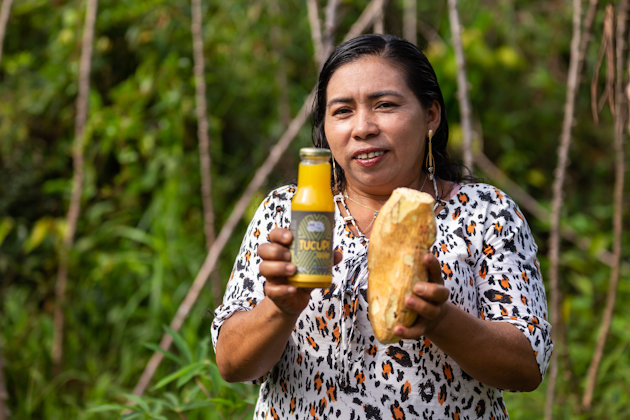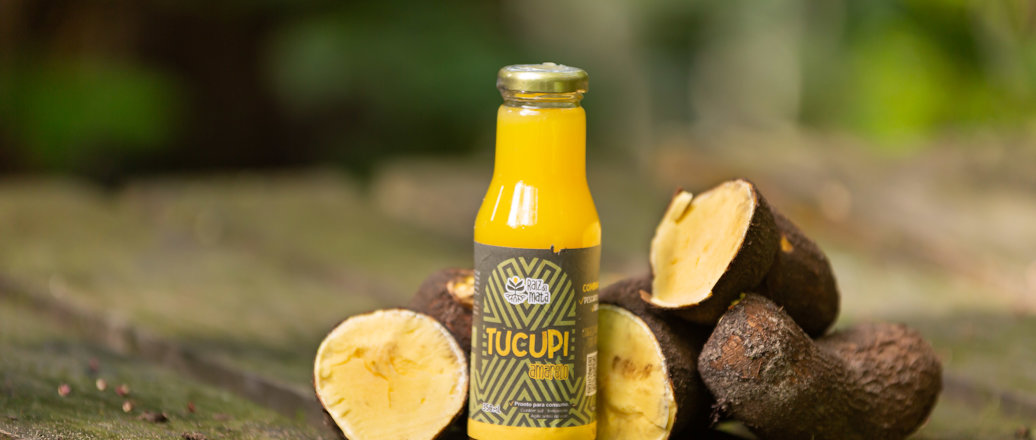Some people do not usually associate tucupi with manioc. This yellowish liquid, known as the gold of the Amazon, is paired with several types of traditional Círio lunch dishes, such as duck in tucupi, Pará rice and tacacá. Tucupi, a traditional sauce from the north of the country, is extracted from wild manioc (Manihot esculenta Crantz). Adored by the people of Pará, the delicacy conquers more and more palates inside and even outside Brazil, as it enchants with its aroma, unique and acidic flavor.
This activity of obtaining tucupi is considered difficult and laborious, due to all the necessary steps. Although there are mechanized equipment, they are most often done manually. Cassava is peeled, grated and pressed. The remaining juice is separated from the starch by decanting. As in this variety of cassava the juice is considered poisonous, due to a compound present in wild cassava, called hydrocyanic acid, the tucupi needs to be boiled for at least twenty minutes before being consumed with regional herbs and hot pepper.
According to nutritionist Leandro Leal, in addition to the gastronomic benefits, tucupi has nutritional advantages: it is a source of vitamin A and has a significant amount of antioxidants. In addition, it is a low-calorie ingredient: about 36 kcal for every 100 g. “Because it is a food rich in carbohydrates, it is interesting to associate its consumption with foods that are rich in fiber. Our traditional duck in tucupi with jambu is a nutritious and balanced option for Círio's lunch, which replenishes the energies lost in the procession. It is important that the place of purchase is reliable and obeys all the tucupi preparation processes, such as fermentation, hygiene and meets the rules of the Health Surveillance”, explains Leandro.
Tucupi has a lot of tradition, coming from the indigenous peoples who invented and popularized it, but also a lot of research. Embrapa scientists work on the identification and genetic improvement of cassava, on the development of more efficient production systems, on co-products to add value and generate income for farmers, and, with that, expand access to different consumer markets.
Active and Tipitix
In Bracarena, Hydro encourages family farming for tucupi production, through the Ativa Barcarena and Tipitix Projects, with Tipitix being financed by the Hydro Sustainability Fund and the Mitsui Foundation, both carried out by the Peabiru Institute.
At Tipitix, launched in March 2021, 448 kilos of products benefited from cassava have already been produced. This production includes coarse cassava flour, tapioca flour, seasoned farofa and vacuum manioc. At the launch of the second cycle of the project, in November 2021, the range of products was expanded with the inclusion of tucupi, brigadeiro and macaxeira cheese bread.
Farmers receive technical assistance support in adapting their business model; infrastructure for processing its production; support in design, credit and commercial advice to place the product and/or service on the market; as well as administrative and accounting support for the procedures related to the formalization and management of the business.
The Ativa Barcarena project, started in 2018, values family farming and sustainable food production to foster the development of a local agri-food system. The program offers free rural technical assistance and trains family producers in organizing the network of productive actors and promoting products with local identity.
In 2022, 91 farmers from 34 rural communities and the islands of the municipality of Barcarena are benefiting. Since the beginning of activities, 392 farming families have participated, resulting in more than 1,500 people benefiting from the project.
Tucupi strengthening family farming

One of the beneficiaries is Raquel Rodrigues Mendes, a participant in the Ativa Barcarena project and selected to participate in the 2nd cycle of Tipitix. “My mother was already working in the fields, planting manioc. I acquired from her all the knowledge to work with tucupi and some techniques of the Ativa project, which allow me to support my family by selling the product at fairs”, says Raquel, who with her support created the Raiz da Mata brand.
With the proximity of Círio, its production increased, from 800 liters of tucupi produced monthly to 1,500 liters. “This season has always been very good for us, orders have increased and now, with large-scale production due to the support received from Hydro, our income has increased and we can offer a better quality product to the consumer. My daughters and I live only from the production of tucupi and it is part of the life of the people of Pará”, says Raquel.
Nutritional benefits of tucupi:
- It is very rich in carotenoids, which have antioxidant properties and are essential in inhibiting free radicals;
- Rich in provitamin A, a substance that gives rise to Vitamin A, extremely beneficial in the development of vision and bones;
- The regular consumption of tucupi, without exaggeration, is essential for the functional capacity of the organs of the reproductive tract, in strengthening the immune system, in the normal development of teeth, in maintaining the good condition of the hair, in addition to protecting the skin and mucous membranes.
: October 4, 2022







